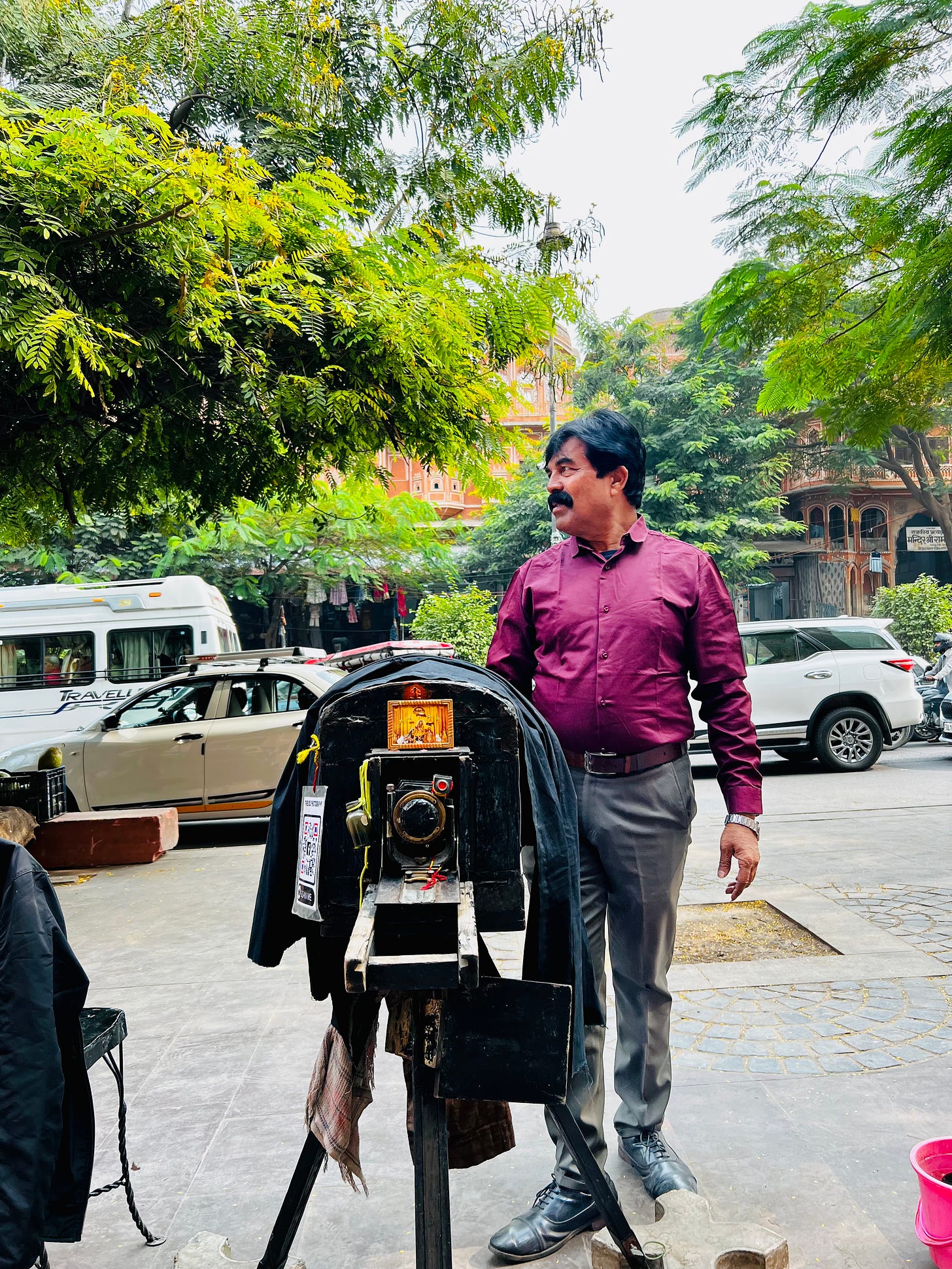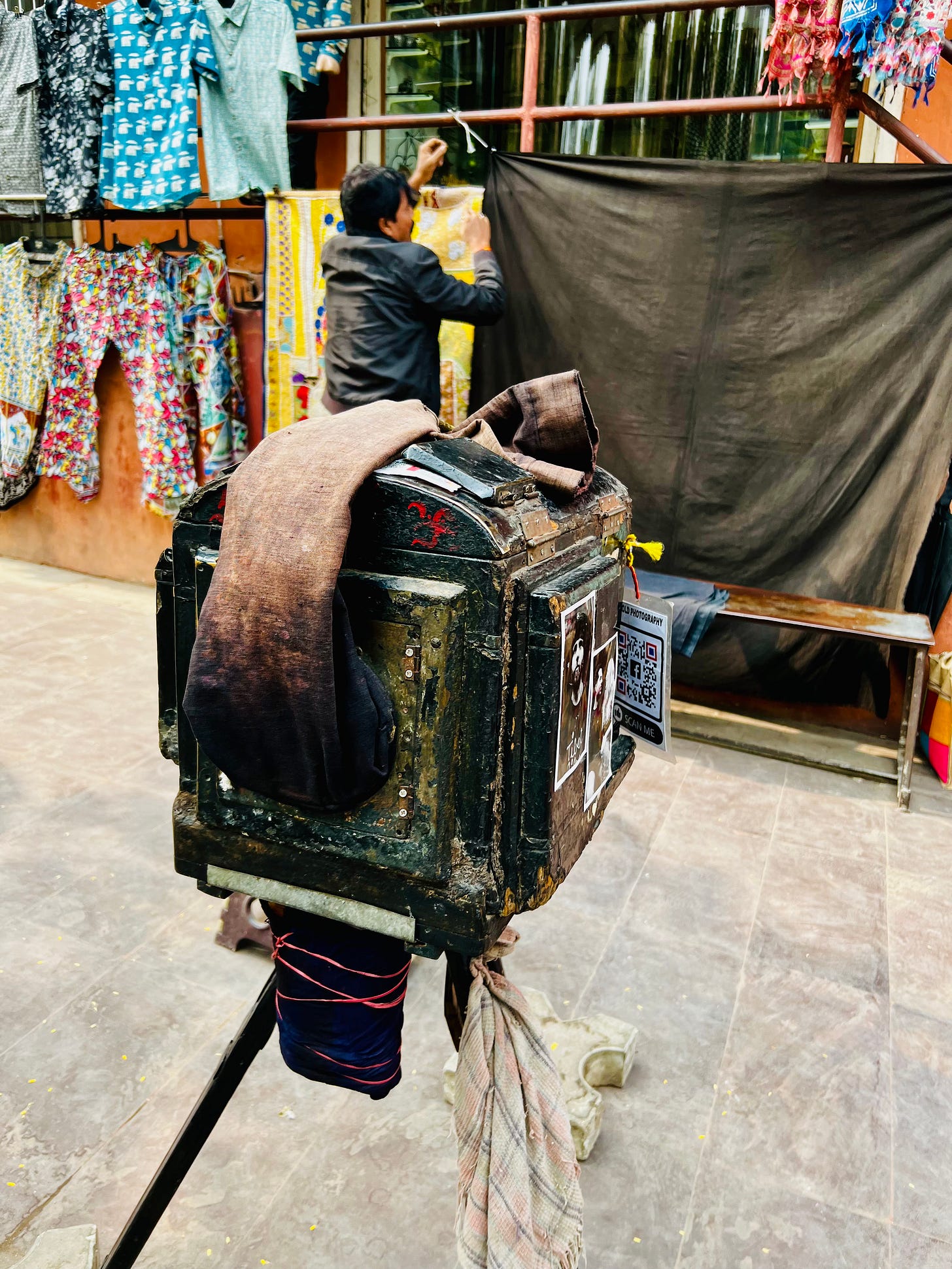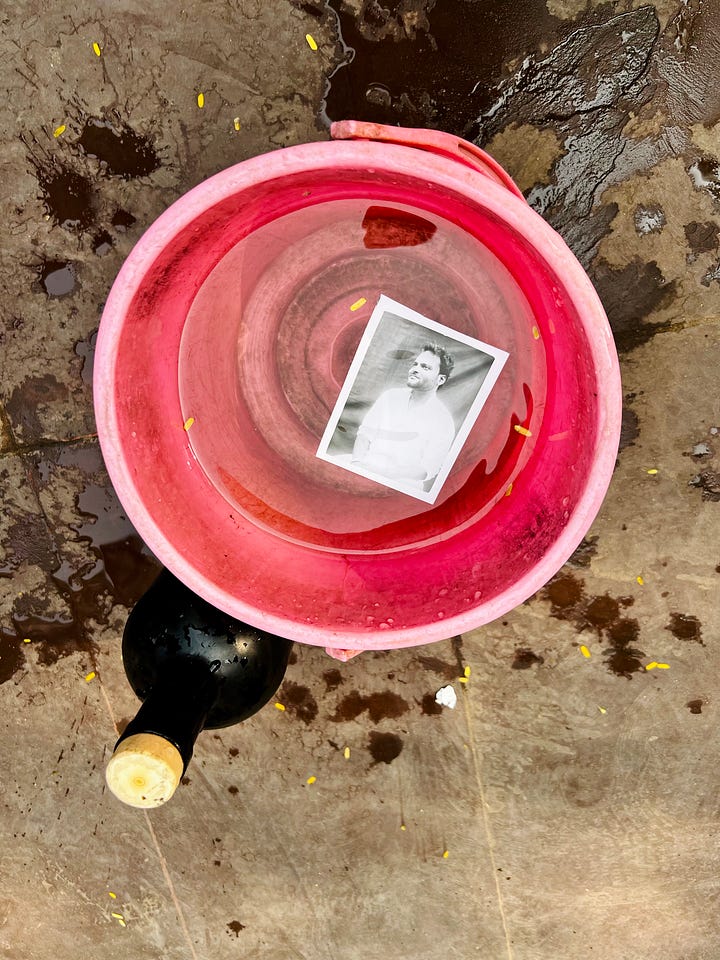Today’s piece is a continuation of my India travel diaries, following my exploration on rekindling childhood friendships and last week’s visual odyssey through Jaipur. If this was forwarded to you, be sure to subscribe so you can join me on this journey.
Through the lens of Jaipur’s last street portraitist

In the pulsating heart of Jaipur’s old city market, a stone’s throw from the architectural marvel that is Hawa Mahal, you’ll stumble upon a relic of history. This is where Tikam Chand, Jaipur’s last portraitist, sits with a companion as ageless as the Pink City itself — his 163-year-old Carl Zeiss camera, one of the last ones of its kind.
Chand greeted me with a joy known only to someone who finds love in his vocation. “This camera is a legacy of love, tracing back to my grandfather Pahari Lal,” he shared when I told him I was writing about my travels and had come to find him after seeing his creation on Instagram. “I hope you will write about me,” he quipped, as he told me his story.
Gifted to his grandfather by the then-Maharaja, the camera in front of me had been a silent witness to the changing eras of Jaipur, with Tikam Chand using it to develop pictures with techniques reminiscent of a bygone era.

After sharing a bit of the camera’s history — the tool that has been his family’s breadwinner for three generations — we got to taking a picture. Under Chand’s direction, I became a subject of his craft. He orchestrated every pose with a director’s precision until, with a flourish, he said: “Ready, set, go,” and, with the swift motion of replacing the lens cap, captured a snapshot.
Considering I was strutting about in Jaipur with an iPhone that could hold tens of thousands of high-quality pictures — and had just captured around 300-odd pictures of the City Palace itself — it was hard to contemplate how it must have been back in the day, when people didn’t have personal cameras. “Tourist destinations were filled with professional photographers like me,” Chand insisted, “and anyone who wanted a keepsake would come by and click pictures in formal poses in front of monuments, often framing and proudly displaying them afterwards.”
While we chatted, Chand’s elder brother worked to develop the picture with his bare hands by dipping the negative in a bucket by our feet and rubbing some chemicals on it, before placing it upside down on a wooden plank and taking another picture of it. This caused the black-and-whites to invert, effectively transforming the negative into a positive.


Now, however, his is a dying and expensive trade. “The special paper and chemicals I need for this camera are nowhere to be found in India,” he explained, adding that he now has to source them from France. But, footfall seemed positively upbeat that day, probably due to the fact that Chand has gotten quite popular on social media — the juxtaposition of a card advertising the QR code to his Instagram handle hanging on his vintage camera wasn’t lost on me.
As he handed me both the photographs, wrapped in days-old newspaper, I was told to let it be for a couple of hours. “Keep them away from sunlight for now; good things take time to develop,” he said, stopping me as I tried to unwrap it to sneak a peek.
This encounter with Chand and observing his creative ritual, I was reminded of the importance of patience and the vanishing era of family trades. Although I take it as a sign of progress that modern India is teeming with opportunities for its youth, I did feel a gush of joy — and a touch of nostalgia — when I heard that this family heirloom will be handed over to Chand’s son, who is set to inherit it as its fourth-generation steward from next year.
As I walked back towards Hawa Mahal, I couldn’t help but notice the paradox of progress amidst the plethora of tourists capturing countless fleeting memories. Our digital age offers us several chances at a perfect shot, and yet here, in the hands of a street portraitist, imperfections weren’t just accepted, but were part of the story: The odd angle, my lack of smile, and the annoying crease on my kurta were all part of the memories I carry of that day and the trip.
In a way, the interaction and experience did teach me that not everything must be flawless — for life, as we well know, is beautifully imperfect.
On that note, I took a stab at recording the process — I’d love to hear your thoughts on it (even if it’s to suggest I stick to writing!):
I hope you’ve enjoyed this edition’s journey through the vibrant streets of Jaipur. I’d love to hear your thoughts and suggestions on what you’d like me to write next — feel free to hit reply and share your impressions.
If this newsletter resonated with you, why not spread the joy? Sharing Infinity Inklings with friends not only helps grow our community of curious minds but also unlocks some exciting rewards:
Receive a heartfelt, handwritten Jaipur postcard for 3 referrals.
Gain access to an exclusive private slack channel for 10 referrals.
Opportunity to suggest a topic for an upcoming newsletter issue, giving you a direct hand in shaping the content, for 25 referrals.



